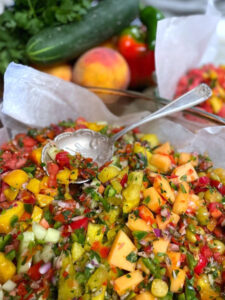A Slice of Summer
A Slice of Summer
It’s Melon season on our farm right now from the beginning of August through October (weather-dependent). We farm over four acres of melons growing seven different varieties including red and yellow seedless watermelon, red and yellow seeded watermelon, muskmelon (AKA cantaloupe), honeydew melon, and canary melon. Belonging to the Cucurbits (Gourd family) these plants need… Read More »

Cucurbits contain two kinds of flowers, most cantaloupes and honeydew have male flowers called staminate as well as perfect flowers which are self-pollinating. Cucumbers and watermelons have both male and female (pistillate) fruit-producing flowers therefore requiring insect pollination. Honeybees are the best suited for the job and you will see them frequenting cucurbit flowers for their energy (nectar) and protein, vitamins and minerals, and lipids (pollen).
Seedless melons are monoecious, separate male and female flowers, making them reliant on cross-pollination to produce fruit. Pollination friends include bees, wasps, butterflies, and other small insects. Seeded melons are self-fertile and require a visit from pollination insects but don’t require cross-pollination between plants. Cucurbit flowers are only open for one day with the male flowers appearing first. The vines produce runner tendrils which can produce four flowers which may produce up to 2 – 4 melons, however, it typically can be less. We grow our melons in rows using contour farming which helps us with water and soil conservation efforts. Learn more about pollinators on our farm.

Preparing simple, easy, no-cook meals is so easy to do with amazing fruits in great abundance







